Abstract
This paper focuses on the study of IoT network deployments, in both unlicensed and licensed bands, considering LoRaWAN and NB-IoT standards, respectively. The objective is to develop a comprehensive and detailed network planning and coverage dimensioning methodology for assessing key metrics related to the achieved throughput and capacity for specific requirements in order to identify tradeoffs and key issues that are related to the applicability of IoT access technologies for representative use case types. This paper will provide a concise overview of key characteristics of IoT representative IoT access network standards that are considered for being deployed in unlicensed and licensed bands and will present a methodology for modeling the characteristics of both access network technologies in order to assess their coverage and capacity considering different parameters.
1. Introduction
Internet of Things (IoT) mainly integrates heterogeneous sensors and actuators for performing tasks in the physical world, using the information obtained from the environment and also considering the specific requirements of applications and services tailored to specific use cases. Various Wireless Sensor Network (WSN) platforms have been proposed to collect sensing information from an observation area and to send to selected network nodes specific actuation commands. The deployment scenarios of WSNs involve the use of a large number of sensors within an observation area to gather a high spatial granularity of measurements that could be then centrally processed and thus provide advanced situation awareness. The high number of sensors also ensures knowledge extraction reliability, even in cases that some sensors are disabled, by using self-healing properties of the WSN communication network. Another important feature that could enhance the capabilities of a WSN is related to the introduction of vehicular sensors (i.e., onboard manned or unmanned vehicles) that could collect measurements on the move, could interact with local clusters of fixed sensors, or could even enable enhanced information collection of specific areas according to triggers and alarms set off by the measurements of the fixed WSN infrastructure.
This envisaged heterogeneous WSN involve the combination of heterogeneity in the following features:
Sensing Capabilities: The sensor nodes may be capable of collecting different types of measurements. Examples of measurement/sensing types are the following: temperature, motion, chemicals/gas leaks, video, audio, and energy.
Mobility Capabilities: Some sensing platforms may be fixed on the ground, whereas some other platforms may be onboard UAVs that will fly over areas of interest to collect data, measurements, and real-time video content.
IoT Access Networks: The sensor nodes may be communicating with each other with various air interfaces, each having different PHY and MAC protocols that result in different performance metrics such as hop link range, energy efficiency, throughput, etc. The network nodes may be interconnected among each other into different topology formations. They may all connect via a single hop to a central cluster head to form a star-shaped network, or they may establish peer–peer connections among them to formulate appropriate mesh networks that will use multihop paths for the communication of the nodes with a sink or cluster head. Hybrid formations utilizing both star and mesh topology principles may also be considered.
Transported Content: The sensing information that will be transported from the end nodes towards the core network and the related processing applications will be of different types. It may involve regular readings (e.g., temperature), event triggers (e.g., motion sensor alerts), and/or streaming content (e.g., audio, video).
There may be multiple WSNs operating modes according to the monitored environment conditions and the applications that will be running. For example, a WSN may be operating in a “regular” (low power/throughput) mode, obtaining periodic measurements from different sensors scattered over the coverage area. In the case of a specific application requirement or an event trigger, a WSN may reconfigure its operation to “zoom”/“focus” on a specific location/area and obtain measurements with a higher rate in order to extract more precise knowledge for the observation area. Additionally, another operation mode may be triggered to enable additional sensing functionalities (such as video capturing) that will require a WSN with different topology, higher throughput, and power characteristics.
The abovementioned heterogeneous WSN and IoT access network features lead to different performance metric combinations in terms of link throughput, achievable coverage and capacity capabilities, and energy efficiency.
It is therefore important to design IoT access network deployments in an efficient way that will consider both the individual access network capabilities and the performance requirements of the applications that will use them. Towards that objective, it will be important to develop accurate yet comprehensive network planning and capacity dimensioning methodologies in order to assess the actual coverage and capacity that can be offered by an IoT access network deployment and to match the relevant present and future use case requirements.
The contributions of this paper are the following: (a) it will provide a concise overview of key characteristics of representative IoT access network standards, namely LoRaWAN and 3GPP NB-IoT, that are considered for being deployed in unlicensed and licensed bands, respectively; (b) it will present a methodology for modeling the characteristics of both access network technologies and for assessing their coverage and capacity considering different parameters.
This paper is structured in the following way: Section 2 provides a concise survey of related works in the area of LoRaWAN and NB-IoT access network characteristics, as well as in terms of assessing their respective coverage and capacity. Then, Section 3 synthesizes the related state-of-the-art principles and presents a complete methodology for assessing analytically the coverage and capacity capabilities of LoRaWAN and NB-IoT. Section 4 then presents results for key application types for both IoT access networks and highlights key tradeoffs in each of them. Finally, Section 5 provides the key paper conclusions and open issues for further study.
2. Background—Related State of the Art
The objective of this section is to present the characteristics of key IoT standards operating in unlicensed and licensed bands, namely LoRaWAN and NB-IoT, respectively, in order to identify their differences and their comparative strengths and weaknesses. LoRaWAN networks are based on star topologies in order to interconnect sensing devices with a gateway. In the physical layer, the modulation is based on LoRa Chirp Spread Spectrum for ensuring efficiency in managing the transceiver power and good operation characteristics in an extended coverage range. It uses proprietary spread spectrum techniques and Gaussian Frequency Shift Keying (GFSK). It also employs wideband linear frequency-modulated pulses, with a varying frequency depending on the encoded information. It requires reduced receiver design complexity also due to the equivalence between transmission and reception timing and frequency offsets [1]. The type of the waveform and the high value of the bandwidth-delay product ensure transmission robustness for addressing issues caused by interference and small-scale fading. This affects the achieved link budget, enabling high-coverage areas for each LoRaWAN gateway that can cover thousands of end devices, for sending intermittently their measurements towards the gateway [2]. A downside of this is related to the relatively low allowable duty cycle for the operation of all these end devices, impacting their individual throughputs and packet rates. In the EU region and in the 863–870 MHz ISM band, there are three obligatory uplink LoRaWAN channels at 868.10, 868.30, and 868.50 that have a maximum duty cycle of 1% [3]. Additionally, LoRaWAN MAC includes three different operation classes: Class A for bidirectional communications consisting of one uplink and two subsequent downlink windows, Class B that includes more scheduled downlink (receive) slots, and Class C with continuously open downlink (receive) windows that are only restricted during uplink transmissions. Moving from Class A to C, latency for downlink transmissions can be reduced at the cost of more power required to maintain the downlink window continuously open [4].
3GPP has also developed standards for addressing the requirements of IoT use case scenarios, with a focus on the reduction of energy consumption, especially on nodes close to the edge of coverage and to simplify hardware architectures and chipsets that could be connected to the existing cellular infrastructure and use parts of the licensed spectrum, such as the Extended Coverage GSM (EC-GSM) [5], the LTE Cat-M [6,7], and NB-IoT [8]. LTE IoT devices have more modest specifications in terms of throughput and power consumption, but they support coverage areas corresponding to power budgets ranging between 155 and 164 dB [7,8]. NB-IoT can support simpler IoT applications involving static sensor topologies and lower throughputs, short-message transmissions, and having moderate delay requirements, with only the requirement to be accommodated within the legacy LTE or GSM spectrum bands (in the latter case following suitable refarming procedures). It should also be noted that EC-GSM may be directly implemented in areas where there is still available 2G network infrastructure providing acceptable performance figures for IoT applications in terms of latency and throughput [9]. In addition, the MulteFire standard [10] has been developed for interworking with LTE networks, and it includes IoT-targeted enhancements such as coverage extension and support of narrowband operation in the ISM bands in 900 MHz and 2.4 GHz [11].
In parallel to the aforementioned IoT access network standardization activities in both licensed and unlicensed bands, there has been increased interest in assessing the various developed standards and modes, in terms of their performance for various use case requirements and scenarios. The authors of [12] performed an assessment of various IoT access network technologies, including Zigbee (Xbee), Bluetooth Low Energy (BLE)m and LoRa/LoraWAN via experimentation of specific devices in order to assess their coverage, throughput, and energy efficiency metrics and demonstrated the superiority of LoRa/LoRaWAN for moderate to high distances (above 100 m) in terms of throughput and energy performance, as compared to the other short-range access network technologies. Additionally, in [13], it was shown via experimentation that LoRaWAN could provide better energy efficiency and hence battery autonomy compared to GPRS in a smart irrigation system, at the expense of a moderate packet round trip time increase (that could be afforded by the specific target application).
Furthermore, network planning for IoT access networks has been studied in many works in the literature. Various works [1,14,15,16] have presented models for estimating the receiver sensitivity, minimum receiver SNR, and Time over the Air (TOA) in LoRaWAN links, without including device capacity estimations. Additionally, in [17], the authors investigated radio channel propagation models for the LoRaWAN 868 MHz band and for evaluating radio coverage for different environment types (indoor, urban, suburban, rural), considering also measurement campaigns. Similar work was conducted for NB-IoT by the authors of [18,19]. These findings motivated the current work in order to perform the coverage planning assessment and cell range calculations for different spreading factors and to further exploit them for device capacity dimensioning. In [20,21], the authors present comprehensive studies regarding the PHY and MAC procedures in NB-IoT, without providing a device capacity assessment. Additionally, in [2], the authors analyze the coverage and capacity of fixed LoRaWAN networks and extend it to mobile use cases in [22]. The present work is inspired by these findings and adopts in the developed models some of the concepts presented in these works, in order to develop an integrated methodology for assessing the coverage and capacity of additional standards such as NB-IoT. In [23,24], key NB-IoT system parameters are presented, and a preliminary analysis of the system throughput is provided, giving valuable insights regarding methodology for coverage and capacity planning in the present work, which extends these ideas to derive maximum numbers of devices depending on cell coverage ranges and on the application payload and packet rate parameters. Furthermore, [25] presents a comprehensive review of radio resource management calculations for NB-IoT, with useful information on the coverage estimation and on the actual packet repetition patterns that are considered in different cell ranges that also inspired the present work.
Our work complements the related state of the art by considering key characteristics of LoRaWAN and 3GPP NB-IoT, in order to formulate an integrated framework for assessing the radio coverage and device capacity for each access network technology. Such composite modeling results are important for considering the deployment characteristics of respective IoT access networks in unlicensed or licensed frequency bands and for determining actual throughput levels, the numbers of supported devices, and the respective radio coverage ranges that can be achieved.
3. Integrated Radio Coverage and Device Capacity Analysis Framework
3.1. Theoretical Approach
The objective of this subsection is to present the mathematical models that were considered for the integrated radio coverage and device capacity dimensioning for LoRaWAn and NB-IoT.
In order to assess the coverage and capacity of LoRAWAN, it is important to briefly study the mechanisms related to channelization, framing, and medium access in PHY and MAC layer, respectively. As discussed in [1,2], in LoRaWAN, there are eight PHY transmission modes that include seven modes using the LoRa modulation (with Spreading Factors (SFs) ranging from 7 to 12) and another mode assuming a Gaussian Frequency Shift Keying (GFSK) modulation. The first six modes utilize a channel bandwidth equal to 125 kHz, whereas the last two modes use 250 kHz. Each mode has its own coverage and throughput figures depending also on the link-layer procedures for transmitting and receiving packets. All LoRaWAN nodes transmit their packets using a pure Aloha access protocol.
Based on the propagation model used in [17] and on the receiver sensitivity values for the different spreading factors reported in [15], Table 1 shows the maximum distance values from the LoRaWAN gateway:

Table 1.
LoraWAN propagation model parameters.
For the abovementioned calculations, the path loss was calculated by the expression
where d is the distance of the device from the LoRaWAN gateway in km, n is the path loss exponent, is the reference path loss, is the loss related to the height of the device antenna , and is the shadowing margin. For the urban scenario, the following values were considered: n = 4.179, , , , and .
For each of the abovementioned distance values, a separate LoRaWAN channel is considered to be used, with increasing spreading factor, trading off throughput for additional coverage.
The symbol rate in LoRa modulation is given by the following expression:
where BW is the channel bandwidth, and SF is the considered spreading factor.
One important metric that captures the actual radio resources required by a device transmission is related to the Time over the Air (ToA) for a transmitted packet and is calculated with Expression (2) [1,2,22]. PL is the application layer payload size in bytes, SF is the spreading factor, DE is the data rate optimization overhead that applies for SFs higher than 10 at 125 kHz channelization, and CR is the coding rate.
The ToA values computed from Expression (2) can lead to the corresponding derivations of the actual device throughput and capacity figures.
The device throughput is given by the following expression:
whereas the actual maximum number of devices that can be supported within the coverage area is equal to:
where is the packet transmission period per device, and is the number of employed LoRaWAN channels. In Expression (4), the Aloha access scheme collisions are considered by dividing the estimated devices’ number over 2e.
For modeling the NB-IoT access network key, PHY and MAC choices in terms of framing and channelization were considered. NB-IoT has three operating modes that involve in-band operation (assuming a Physical Resource Block (PRB) within the standard LTE band); a guard-band mode, where NB-IoT uses an LTE guard band that is not used by LTE; and a standalone mode, where NB-IoT uses one legacy GSM carrier. One frame of 10 ms duration consists of 10 subframes of duration 1 ms each. Each subframe is further subdivided into two slots of a 0.5 ms duration each. During each slot, a number of SC-FDMA subcarriers are transmitted, leading to the generation of seven symbols per slot. The total bandwidth occupied by the subcarriers is equal to 180 kHz, and there are 2 choices for the actual subcarrier bandwidths: either there are 12 subcarriers occupying each 15 kHz or 48 subcarriers with respective individual bandwidths equal to 3.75 kHz.
The model currently considers the uplink direction, where there are two specific channels: The Narrowband Physical Random-Access Channel (NPRACH) for accessing the network resources and the Narrowband Physical Uplink Shared Channel (NPUSCH), which is used for transmitting data and control information [21].
In the case of NB-IoT, the focus is on devices that transmit measurement data towards the base station; therefore, the objective is to model the key mechanisms that are related to uplink coverage and capacity.
During the uplink, there is an initial random-access procedure where the device sends an NPRACH using a narrowband subcarrier (of 3.75 kHz) with a respective frequency hopping pattern. The duration of the NPRACH transmission is considered to be equal to 5.6 ms. After successful reception of the NPRACH transmission (without any collisions with other contending devices), the device receives an appropriate PRB allocation to send a data packet (using an NPUSCH) via a specific combination of subcarriers and slots.
The following table (based on [25]) shows representative combinations of frequency and time resources that can be considered. A Resource Unit (RU) consists of a number of SC-FDMA subcarriers and slots. Each SC-FDMA symbol within and RU represents a Resource Element (RE).
The number of required NREs for an NPUSCH transmission of PL bytes can be expressed as [24]:
where CR is the code rate, and is the number of bits/symbols (equal to 2 assuming QPSK modulation).
The number of the required RUs can then be calculated with the following expression:
where are the numbers of subcarriers, slots, and SC-FDMA symbols per RU, respectively.
Following that, the required transmission duration for the required RUs can be calculated:
where is the RU duration, as shown in Table 2.

Table 2.
NB-IoT uplink transmission options (15 kHz subcarriers).
In order to ensure the reception of the uplink packets on all considered ranges, a number of NPUSCH retransmissions is defined by the standard. According to [25] these repetitions can be assumed was shown in Table 3:

Table 3.
NB-IoT range-based uplink repetitions.
Therefore, the actual ToA for an NB-IoT uplink data transmission can be expressed as:
Finally, the actual number of users that can be accommodated with one RACH period can be expressed as:
where the slotted Aloha access scheme collisions are considered by dividing the estimated devices’ number over e [26].
Considering also as the packet transmission period per device, the total number of devices that can be covered is the following:
3.2. Methodology
The overall coverage and capacity dimensioning consists of the following steps:
Radio Coverage Planning: This is related to link budget calculations to determine the maximum achievable range of the IoT Access Network, considering transceiver characteristics, maximum transmission power levels, antenna gains, path loss models, receiver sensitivity, and minimum SNR threshold values for achieving the required Quality of Service.
Traffic Assessment: This is related to the determination of the required PHY layer bits and symbols that have to be transmitted over the air in order to convey the required application layer packet bytes. It involves the determination of the Time over the Air (ToA) of each device transmission, the consideration of the transmission activity and traffic models for the assumed application per user, the calculation of the maximum number of available time and frequency resources for data, and control channels, as well as the consideration of different transmission modes employed for different ranges within the coverage area.
Network Dimensioning: This involves the actual calculation of the maximum number of devices that can be covered by an IoT base station or a gateway, the level of the achieved throughput per device or per base station, and the actual spare capacity that can be secured for future network expansion steps.
The methodology outputs can be directly used or can be fed back for further modification of the model inputs in order to refine the expected application requirements and network coverage targets. Figure 1 depicts the overall methodology procedure.
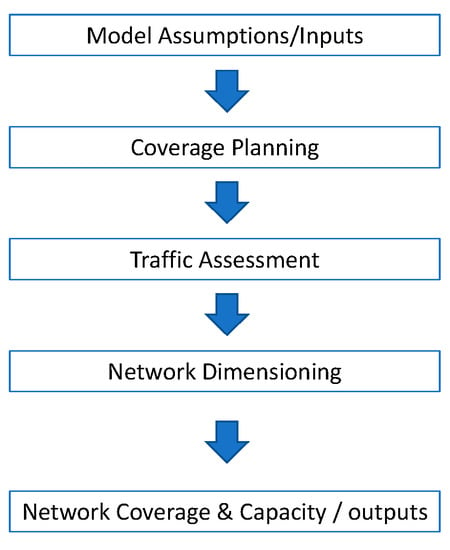
Figure 1.
Coverage and capacity assessment methodology.
4. Model Results
In order to test both aforementioned models, a number of IoT services was assumed. Their characteristic parameters are shown in Table 4:

Table 4.
IoT Service parameters.
For LoRaWAN, it was assumed that different spreading factors are employed in different cell ranges. Additionally, three 125 kHz channels are assumed to be employed within the cell. In all scenarios, the packet preamble was considered to consist of 8 bits, and the packet header included 13 bits. The tests assumed unacknowledged mode uplink transmission by Class A devices following the methodology of [2].
Figure 2 illustrates the ToA values for the different scenarios. It can be seen that Scenario 3 results in larger ToA values due to its more demanding requirements in terms of the required application bytes to be transmitted per unit time (50 bytes per 5 min). This is also shown in Figure 3, which depicts the throughput variation versus the cell range for the different scenarios. Finally, Figure 4 depicts the maximum number of devices for each of the cell range zones for the three scenarios. Here it is interesting to observe that the highest device capacity is achieved for Scenario 2 (sending 20 bytes per 10 min), followed by Scenario 3 (sending 50 bytes per 10 min), leaving last Scenario 1 (sending 1 byte every 30 s). It can be seen that Scenarios 1 and 2 have much different performance results even though the actual byte transmission rates are the same (1.33 bytes/s). This is due to the fact that the duty cycle of Scenario 1 is much higher than that of Scenario 2. The Duty Cycle (DC) is expressed as:
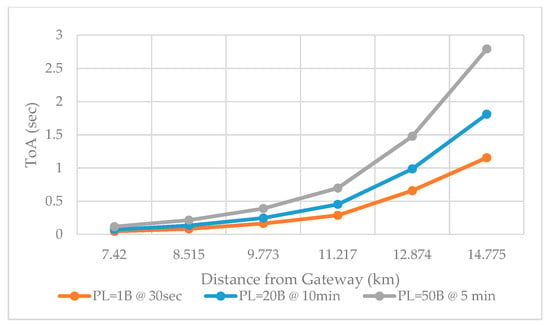
Figure 2.
LoRaWAN Time over the Air (ToA) for different application payloads and packet rates.
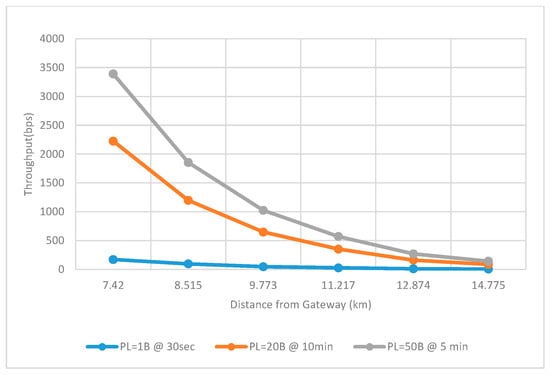
Figure 3.
LoRaWAN device throughput for different application payloads and packet rates.
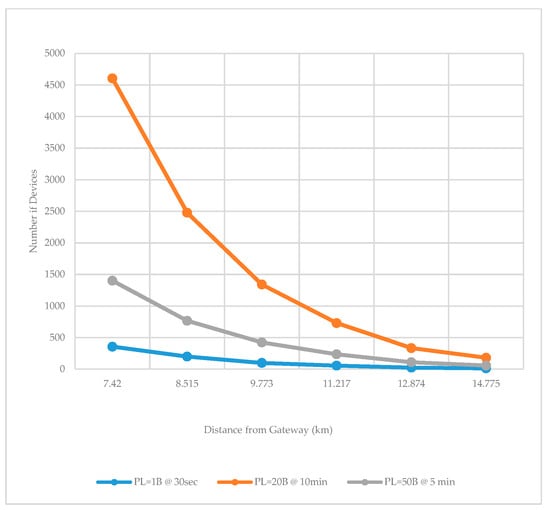
Figure 4.
LoRaWAN device capacity for different application payloads and packet rates.
Figure 5 depicts the various DC values for Scenarios 1, 2, and 3. It can be seen that Scenario 1 has the highest duty cycle values, approaching the maximum theoretic allowable limit of 1% [2].

Figure 5.
Duty cycle values for different application payloads, packet rates, and ranges.
Considering the NB-IoT model, results have been obtained for similar metrics, assuming a PRB of 180 kHz utilizing for the uplink a subcarrier spacing equal to 15 kHz and an RU that consists of 3 SC-FDMA subcarriers and 8 slots, including 168 REs.
Figure 6 depicts the ToA values for Scenarios 1, 2, and 3. The difference among the various cell ranges is due to the increase in repetitions from one up to four, which inevitably increases the ToA for each packet transmission. Scenario 3 has the highest ToA values and also the highest throughput values, as shown in Figure 7. However, Scenario 2 is shown to achieve the highest device capacity per cell as depicted in Figure 8.
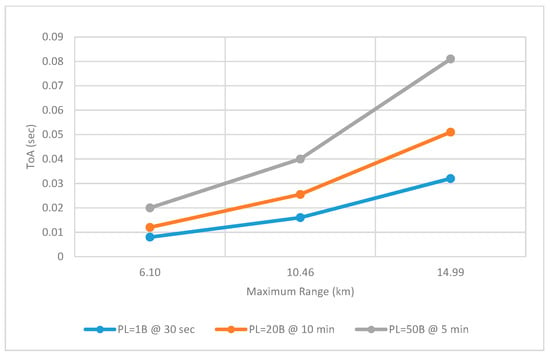
Figure 6.
NB-IoT Time over the Air (ToA) for different application payloads and packet rates.
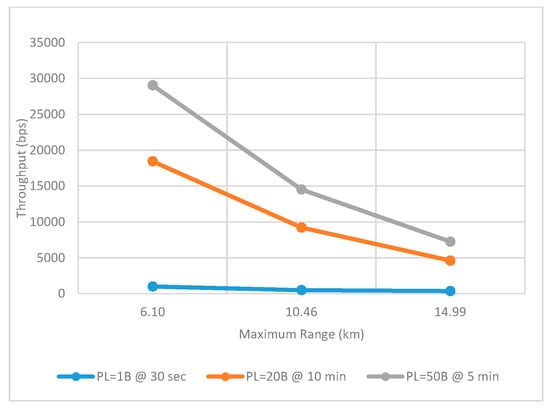
Figure 7.
NB-IoT device throughput for different application payloads and packet rates.
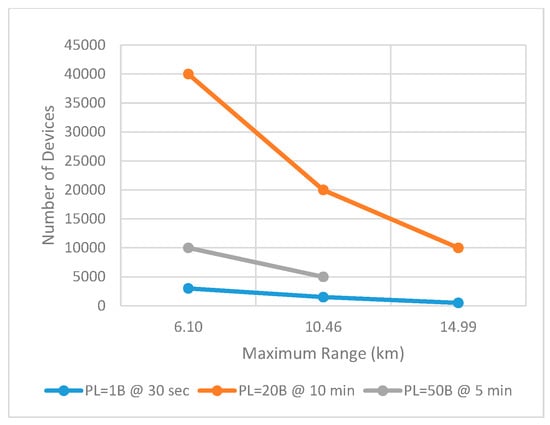
Figure 8.
NB-IoT device capacity for different application payloads and packet rates.
5. Conclusions
This paper provided a study of IoT network deployments, in both licensed and unlicensed bands, focusing on LoRaWAN and 3GPP NB-IoT, respectively. It presented a comprehensive and detailed network planning and coverage dimensioning methodology for assessing key metrics related to the achieved throughput and capacity for specific use case requirements in order to identify tradeoffs and key issues that are related to the applicability of IoT access technologies for representative application types. The paper showed the key features of LoRaWAN and NB-IoT access network technologies that were considered in the presented methodology, which was then demonstrated, and key capacity and coverage results were presented for different use case parameters and access network deployments. Future work will focus on extending the comparison between LoRaWAN and NB-IoT in order to include further operation modes and to also study applications related to bidirectional communication patterns between base stations and end devices. This methodology will motivate the implementation of real-life experimentation scenarios in order to compare theoretical estimations against real network coverage and capacity metrics.
Author Contributions
Conceptualization, G.A., N.D., S.A. and O.B.; methodology, G.A., N.D., S.A. and O.B.; validation, G.A., N.D.; formal analysis, G.A., N.D.; investigation, G.A., N.D., S.A. and O.B.; writing—original draft preparation, G.A., N.D., S.A. and O.B.; writing—review and editing G.A., N.D., S.A. and O.B.; project administration, G.A.; funding acquisition, G.A. All authors have read and agreed to the published version of the manuscript.
Funding
This research has been partly funded by the General Funded Project Grant 153138 “Research on Internet of Things Technologies for advanced Crowd Management Monitoring Applications during Hajj and Umrah”, Deanship of Scientific Research, King Abdulaziz University.
Data Availability Statement
Not Applicable, the study does not report any data.
Conflicts of Interest
The authors declare no conflict of interest.
References
- Semtech Application Note AN1200.22 LoRa Modulation Basics. Available online: www.semtech.com (accessed on 23 April 2021).
- Mikhaylov, K.; Petäjäjärvi, J.; Hänninen, T. Analysis of Capacity and Scalability of the LoRa Low Power Wide Area Network Technology. In Proceedings of the European Wireless 2016, Oulu, Finland, 18–20 May 2016. [Google Scholar]
- LoRa Alliance Technical Committee. LoRaWAN 1.0.2 Regional Parameters. Available online: www.lora-alliance.org (accessed on 23 April 2021).
- Sornin, N.; Luis, M.; Eirich, T.; Kramp, T.; Hersent, O. LoRaWAN Specification V1.0.2. Available online: www.lora-alliance.org (accessed on 23 April 2021).
- Tabbane, S. IoT Standards Part II: 3GPP Standards/Training on Planning Internet of Things (IoTs) Networks. Available online: https://www.itu.int/en/ITU-D/Regional-Presence/AsiaPacific/Pages/Events/2018/IoT-BDG/Presentations.aspx (accessed on 23 April 2021).
- Hwang, Y. Cellular, IoT Explained–NB-IoT vs. LTE-M vs. 5G and More. Available online: https://www.iotforall.com/cellular-iot-explained-nb-iot-vs-lte-m/ (accessed on 23 April 2021).
- Reininger, P. 3GPP Standards for the Internet-of-Things. In Proceedings of the Smart Summit, Singapore, 30 November 2016; Available online: https://www.3gpp.org/images/presentations/2016_11_3gpp_Standards_for_IoT.pdf (accessed on 23 April 2021).
- Akpakwu, G.A.; Silva, B.J.; Hancke, G.P.; Abu-Mahfouz, A.M. A Survey on 5G Networks for the Internet of Things: Communication Technologies and Challenges. IEEE Access 2018, 6, 3619–3647. [Google Scholar] [CrossRef]
- Vos, G. What is LPWA for the Internet of Things? Part 3: A Guide to Decoding the Technologies. Available online: https://www.sierrawireless.com/iot-blog/iot-blog/2016/08/lpwa_for_the_iot_part_3_a_guide_to_decoding_lpwa_technologies/ (accessed on 15 April 2021).
- Multefire Alliance, MulteFire Release 1.0 Technical Paper: A New Way to Wireless. Available online: https://www.multefire.org/wp-content/uploads/MulteFire-Release-1.0-whitepaper_FINAL.pdf (accessed on 15 April 2021).
- Multefire Alliance, MulteFire Release 1.1 Technical Overview White Paper. Available online: https://www.multefire.org/technology/specifications/multefire-release-1-1-technical-overview-white-paper/? (accessed on 15 April 2021).
- Tomtsis, D.; Kokkonis, G.; Kontogiannis, S. Evaluating existing wireless technologies for IoT data transferring. In Proceedings of the 2017 South Eastern European Design Automation, Computer Engineering, Computer Networks and Social Media Conference (SEEDA-CECNSM), Kastoria, Greece, 23–25 September 2017; pp. 1–4. [Google Scholar]
- Kontogiannis, S.; Kokkonis, G.; Ellinidou, S.; Valsamidis, S. Proposed Fuzzy-NN Algorithm with LoRaCommunication Protocol for Clustered Irrigation Systems. Futur. Internet 2017, 9, 78. [Google Scholar] [CrossRef]
- Semtech. LoRa SX1272/3/6/7/8 Modem Designer’s Guide AN1200.13. Available online: www.semtech.com (accessed on 23 April 2021).
- Semtech. LoRa SX 1276/77/78/79 Wireless Sensing and Timing Datasheet, Rev.4. Available online: www.semtech.com (accessed on 23 April 2021).
- Barriquello, C.H.; e Silva, F.E.S.; Bernardon, D.P.; Canha, L.N.; Ramos, M.J.D.S.; Porto, D.S. Fundamentals of Wireless Communication Link Design for Networked Robotics. Serv. Robot. 2018, 127–142. [Google Scholar] [CrossRef]
- El Chall, R.; Lahoud, S.; El Helou, M. LoRaWAN Network: Radio Propagation Models and Performance Evaluation in Various Environments in Lebanon. IEEE Internet Things J. 2019, 6, 2366–2378. [Google Scholar] [CrossRef]
- Caso, G.; Alay, Ö.; de Nardis, L.; Brunstrom, A.; Neri, M.; di Benedetto, M.-G. Empirical Models for NB-IoT Path Loss in an Urban Scenario. IEEE Internet Things J. 2021. [Google Scholar] [CrossRef]
- Matz, A.P.; Fernandez-Prieto, J.-A.; Cañada-Bago, J.; Birkel, U. A Systematic Analysis of Narrowband IoT Quality of Service. Sensors 2020, 20, 1636. [Google Scholar] [CrossRef] [PubMed]
- Kanj, M.; Savaux, V.; Le Guen, M. A Tutorial on NB-IoT Physical Layer Design. IEEE Commun. Surv. Tutor. 2020, 22, 2408–2446. [Google Scholar] [CrossRef]
- Wang, Y.-P.E.; Lin, X.; Adhikary, A.; Grövlen, A.; Sui, Y.; Blankenship, Y.; Bergman, J.; Razaghi, H.S. A Primer on 3GPP Nar-rowband Internet of Things. IEEE Commun. Mag. 2017, 55, 117–123. [Google Scholar] [CrossRef]
- Petajajarvi, J.; Mikhaylov, K.; Pettissalo, M.; Janhunen, J.; Linatti, J. Performance of a low-power wide-area network based on LoRa technology: Doppler robustness, scalability, and coverage. Int. J. Distrib. Sens. Netw. 2017, 13. [Google Scholar] [CrossRef]
- Feltrin, L.; Marri, A.; Paffetti, M.; Verdone, R. Preliminary evaluation of NB-IOT technology and its capacity. In Dependable Wireless Communications and Localization for the IoT Workshop; COST Action IRACON: Graz, Austria, 2017. [Google Scholar]
- Feltrin, L.; Tsoukaneri, G.; Condoluci, M.; Buratti, C.; Mahmoodi, T.; Dohler, M.; Verdone, R. Narrowband IoT: A Survey on Downlink and Uplink Perspectives. IEEE Wirel. Commun. 2019, 26, 78–86. [Google Scholar] [CrossRef]
- Malik, H.; Pervaiz, H.; Alam, M.M.; Le Moullec, Y.; Kuusik, A.; Imran, M.A. Radio Resource Management Scheme in NB-IoT Systems. IEEE Access 2018, 6, 15051–15064. [Google Scholar] [CrossRef]
- Sharma, S.K.; Wang, X. Toward Massive Machine Type Communications in Ultra-Dense Cellular IoT Networks: Current Issues and Machine Learning-Assisted Solutions. IEEE Commun. Surv. Tutor. 2020, 22, 426–471. [Google Scholar] [CrossRef]
Publisher’s Note: MDPI stays neutral with regard to jurisdictional claims in published maps and institutional affiliations. |
© 2021 by the authors. Licensee MDPI, Basel, Switzerland. This article is an open access article distributed under the terms and conditions of the Creative Commons Attribution (CC BY) license (https://creativecommons.org/licenses/by/4.0/).